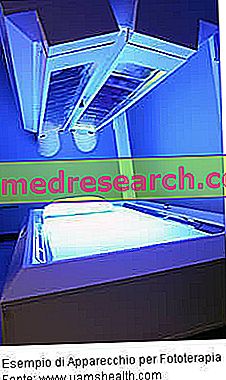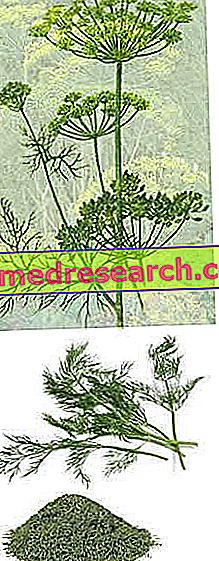What is phototherapy
Phototherapy is a healing technique based on the use of light (from the Greek, "light therapy"). It is usually applied to the treatment of dermatological disorders (psoriasis, acne, eczema), sleep (alterations of the circadian rhythm, insomnia) and some psychiatric illnesses (seasonal affective disorder).

During the phototherapy session the subject is placed near a source of natural light (sun, see heliotherapy) or artificial (eg "light box") for a variable exposure time (from half an hour to two hours, generally in the morning). The principle of the application of this treatment is the following: the "light box" emanates light simulating the external natural lighting (solar); all this stimulates the "chemicals" that act on the brain, producing an effect on the mood or synchronizing the circadian rhythms.
In phototherapy, the forms of light can vary in type, color and intensity: for example, with broad-spectrum light, solar radiation is simulated, while with the soft laser (at low intensity) a light beam is focused in order to alleviate pain and inflammation.
The application of phototherapy developed in the 1980s, following the study of a particular form of depression, with recurrent symptoms and characterized by a seasonality model: seasonal affective disorder (SAD). In fact, the very definition of SAD is based on the observation that exposure to an artificial light source significantly reduces the characteristic symptoms of the disorder.
Following this application, in addition to confirming its effectiveness as an adjuvant in the treatment of different forms of depression, phototherapy has proved to be useful for the treatment of sleep disorders: it can therefore help individuals who suffer from insomnia, jet lag, and those who perform night work shifts or patients with more complex alterations of circadian rhythms, involving, for example, serotoninergic, noradrenergic and dopaminergic systems.
Phototherapy is considered a therapeutic tool suitable, in particular, for patients who are not responsive to drug treatments or who have adverse side effects to conventional medical treatment.
Note. The real effectiveness of phototherapy is demonstrated for the treatment of SAD and some dermatological diseases; the results of the treatment for some particular forms of depression and for the application to eating disorders are less convincing. For these pathologies it is necessary to deepen the study of the effectiveness of phototherapy, also in relation to the physiological mechanisms of action that characterize the various pathological conditions. This knowledge could be useful for adapting phototherapy to future clinical applications.
Types of Phototherapy
Phototherapy involves the use of light for the treatment of particular clinical disorders.
Over time, exposure to natural light has been widely recommended as an adjuvant in the treatment of certain dermatological problems (example: heliotherapy for the treatment of psoriasis). Phototherapy in particular uses ultraviolet radiation, at different wavelengths.
Note. Phototherapy applied to dermatological disorders involves the use of a lamp that emits ultraviolet (UV) rays. This type of light is filtered by special "light boxes", so that eyes and skin are not damaged.
Patients can be treated with:
- Broadband UV-B spectrum (full B ultraviolet spectrum)
- Narrow-band UV-B spectrum (uses a small part of the UV-B spectrum)
- P-UVA (Psoralen + UV-A): consists of the combination of UV-A spectrum radiations with a "sensitizer". Psoralen is a medicine taken orally (it is a furanocumarin) that increases the effect of UV-A radiation on the skin and for this reason the P-UVA application is also called photochemotherapy.
- Photodynamic therapy : it is a form of phototherapy which, similar to the previous case, uses non-toxic photosensitizing compounds activated by beams of light at a predetermined wavelength; once activated, these drugs become selectively toxic to malignant or pathological cells.
For whom it is indicated
Treatment based on exposure to light radiation is recommended for a number of reasons:
- It is a proven therapy for seasonal affective disorder and recommended for other conditions (depression and insomnia).
- Light therapy has proved useful for the treatment of skin disorders, especially psoriasis.
- The treatment is safe and has few side effects.
- It helps to increase the effectiveness of antidepressant drugs or other psychotherapeutic regimens.
- It allows you to take, on the advice of your doctor, a lower dose of antidepressant drugs.
Phototherapy for pathological conditions other than SAD
In addition to the treatment of seasonal affective disorder (SAD), phototherapy is the subject of continuous studies to validate its effectiveness in the treatment of other conditions:
- Jet lag
- Sleep disorders
- Mood and anxiety disorders
- Alterations of the circadian rhythm
- pathogenic mechanisms influenced by the trend of the internal biological clock and seasonality
- alterations in the regulation systems of serotonin, dopamine or noradrenaline
- Different forms of depression (not connected to a seasonal trend)
- unipolar depression
- major depression
- pre and postpartum depression
- Attention deficit hyperactivity disorder (ADHD)
- Dementia
- Parkinson's disease
- Psoriasis
- Neonatal jaundice
- Menstrual Dysphoric Disorder (DDPM)
- Eating behavior disorders (example: bulimia nervosa)
Phototherapy and psoriasis
Psoriasis is a chronic inflammatory disease of the skin, mediated by the immune system.
Ultraviolet radiation has shown efficacy in suppressing the inflammation process, reducing immunological reactivity.
Phototherapy can help cure psoriasis by applying the following light radiations: UV-B (280-315 nm) and UV-A (315- 400 nm, generally combined with Psoralen).



